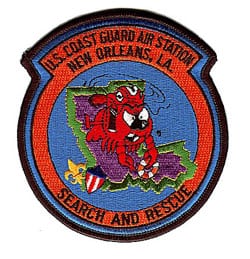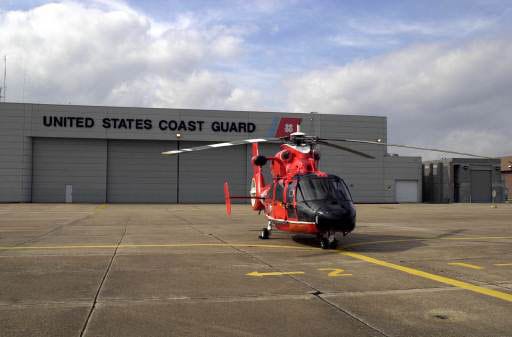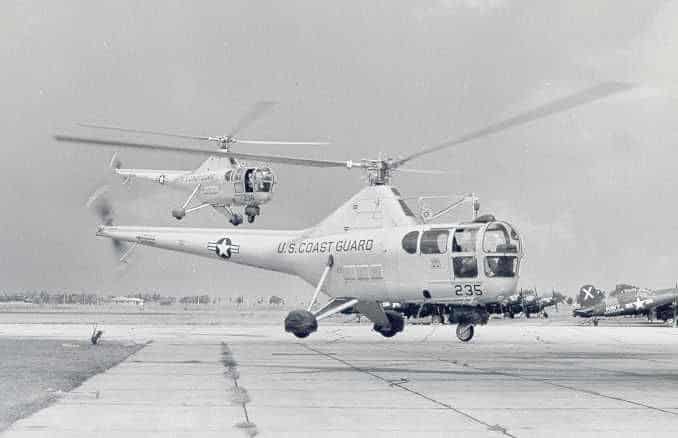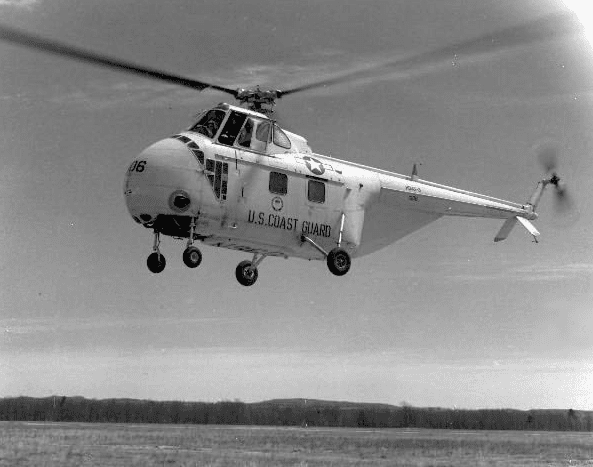 In July of 1955 a two aircraft Coast Guard air detachment was permanently establish at the Naval Air Station New Orleans, Louisiana. The detachment consisted of four pilots and seven enlisted personnel flying two Sikorsky HO3S-1G helicopters. The air station was located on the northern edge of the city on the shores of Lake Ponchartrain. Originally commissioned in 1941 as a Naval Reserve Air Base the base was redesignated a Naval Air station in 1942 and assumed the role of a primary training base for student aviators. In 1946 the training of selected Naval Air reservists became its task.
In July of 1955 a two aircraft Coast Guard air detachment was permanently establish at the Naval Air Station New Orleans, Louisiana. The detachment consisted of four pilots and seven enlisted personnel flying two Sikorsky HO3S-1G helicopters. The air station was located on the northern edge of the city on the shores of Lake Ponchartrain. Originally commissioned in 1941 as a Naval Reserve Air Base the base was redesignated a Naval Air station in 1942 and assumed the role of a primary training base for student aviators. In 1946 the training of selected Naval Air reservists became its task.
The air detachment was busy from the start and HO3Ss were soon replaced by Sikorsky HO4S-3G helicopters which greatly upgraded search and rescue capabilities of the unit. Specially built for the Coast Guard, the HO4S-3Gs were the last of the HO4S/H19s Sikorsky built and were the first helicopters equipped for instrument and night operations.
The New Orleans air detachment mission was search and rescue. Located on the lower Mississippi River, New Orleans is the world’s busiest commercial port; fishing and shrimping takes place in lakes, bayous and off-shore along the coasts of Alabama, Mississippi, and Louisiana; The oil industry operates in the off shore waters; the pleasure boat traffic grew exponentially and New Orleans is in an area subject to summer hurricanes. Typical assistance cases were medico evacuations, assistance to sinking vessels, rescue of those in peril, locating the lost and overdue, and hurricane rescue assistance. The area of responsibility stretches from the pan handle of Florida to the Texas border in the west.
Initial construction of a joint air reserve training center located 15 miles south of New Orleans began in 1954 and it was commissioned in December of 1957 as NAS New Orleans, Alvin Callender Field. Units of the Navy and Marine Corps Reserve moved from the lakefront location. An Air Force Reserve Unit from Ellington Field and a Louisiana Air National Guard squadron moved in. The Coast Air Detachment also moved to the new Naval Air Station. The detachment later became Coast Guard Air Station New Orleans. New hangar facilities designed and built by the Coast Guard were opened and dedicated in September of 1968. The buildings provide maintenance facilities, administrative offices and supply areas. Quarters for the ready flight crews and an operations center were also located in the hangar. In 1986 a separate building to house administration, medical, and operations department was constructed. In later years additional missions such as maritime law enforcement, survey flights in support of pollution control and co-operative efforts with local and Federal agencies were added to the air station responsibilities.
The progress in the development of the helicopter is illustrated well in the history of aircraft assigned to the New Orleans air station. The HO4S was replaced by the HUS-1, the last of the piston engined helicopters. These were in turn replaced by the HH-52, an amphibious jet-engined helicopter, and the most prolific life saver of any helicopter built to date. In 1969 New Orleans was the first air station to operate the twin-engine HH-3F amphibian helicopter. In June 1980 the HH-52 again returned to the air station inventory. During 1985 New Orleans became the first air station to operate the new HH-65.

The HH-65 has an advanced electronics package and a computerized navigation system integrated with the autopilot and a nose mounted forward looking infra-red radar to aid rescue missions by night, in bad weather and in high sea states This is in stark contrast to 1956 when a HO4S would depart the air station for an off-shore medical evacuation from a ship in the Gulf of Mexico. On the way out a stop would be made at Pilottown, Louisiana, 65 air miles south of New Orleans and just north of the mouth of the Mississippi River. The helicopter topped off with fuel from 55 gallon drums and then departed for the medico. Upon leaving Pilottown the HO4S picked up its UF-1G Albatross escort which navigated for the helicopter, served as a communication center, obtained DF bearings on the merchant vessel’s radio transmissions and provided assistance in case the helicopter went down. These flights were made both day and night and in both visual and instrument flight conditions. At night or in IFR conditions the helicopter pilot’s full attention was required just to fly the helicopter. Today’s Automatic Stabilization Systems were not yet available. Depending on winds and fuel state, the return flight either went directly to the hospital helicopter pad in New Orleans or if required, it again stopped at Pilottown or Grande Isle to obtain sufficient fuel to reach New Orleans.
Search and Rescue remains the primary mission but over one quarter of the unit’s flight time is dedicated to Homeland Security duties—most notably ports, waterways, and coastal security (PWCS) security flights, Federal and State Joint Operations, and providing supplemental crews for the rotary wing intercept mission. Air Station New Orleans has a large Auxiliary Aviation contingent which works closely with five Sector Commands and the air station to carry out safety patrols, spill response and detection, PWCS, and search and rescue.
The year 2005 was the fiftieth year of operation for Air Station New Orleans. The average number of cases per year had risen to over 500. It was also the year of Hurricane Katrina which was the costliest and one of the deadliest hurricanes in the history of the United States. The Coast Guard and the New Orleans air station did a magnificent job. Air Station crews from Mobile, Houston, and New Orleans, supplemented by personnel from other units, saved 3,689 lives. In the spring of 2006, CAPT Bruce Jones, commanding officer of Air Station New Orleans and Captain Frank Paskewich, commander of Coast Guard Sector New Orleans, presided at a ceremony where more than 115 personnel received medals and awards for heroism.
During its 50-year plus history, the Air Station has saved more than 5600 lives and has been awarded twelve Meritorious Unit Commendations, five Coast Guard Unit Commendations, and was selected by the Commandant to receive, for the Coast Guard, the Presidential Unit Citation.
Coast Guard Air Station New Orleans and the professionals who have filled her rolls, have historically been the tip of the trident in the Gulf of Mexico region, providing comfort, care, and aid whenever and wherever needed. The proud tradition continues.


